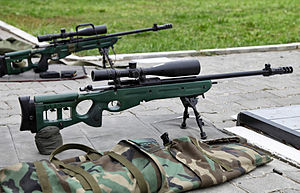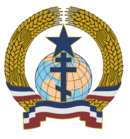Letnian Army: Difference between revisions
(No difference)
|
Revision as of 01:48, 13 September 2018
| Soviet Army | |
|---|---|
| Советская Армия | |
| File:LetnevArmy.png Army Flag adopted in 1992 | |
| Founded | 1904 |
| Current form | 1921 |
| Headquarters | Turov, FSR |
| Leadership | |
| Marshal of the Federation | Vetrov Zhukov |
| Minister of Defense | Kashnikov Milorad |
| Personnel | |
| Military age | 18 |
| Conscription | 2 years |
| Active personnel | 1,000,000 |
| Reserve personnel | 1,515,000 |
| Deployed personnel | 140,000 |
| Expenditure | |
| Budget | $158.23 billion OSD (2017) |
| Percent of GDP | 2.20% |
The Soviet Army (Letnevian: Советская Армия) refers to the combined ground forces of the Federation of Soviet Republics, formed in the aftermath of the Letnevian Revolution in 1902. Soviet ground forces are deployed in all CNCS states, as well as many other states and territories worldwide.
Mission
The primary responsibilities of the Army is the protection of the state borders, combat on land, the security of occupied territories, and the defeat of enemy troops. The Army must be able to achieve these goals both in nuclear war and non-nuclear war, especially without the use of weapons of mass destruction. Furthermore, they must be able to secure the national interests of the Federation of Soviet Republics both domestically and abroad.
History
Post Civil War
The Soviet Army was officially created by the Soviet government on March 1st, 1911. The new army was mainly comprised of "White Soviet" troops from the civil war. Many of the officers from the Tsarist era were allowed to stay in service. Roughly 80% of the officer corps in the Soviet Army post civil war was made up of Tsar-era officers and specialists. The early army was small, ill-equipped, and made up entirely of poorly paid volunteers. There were special units made of some ethnic groups, and Cossack units remained in service in many areas.
By the time of the War of Sylvan Succession, in 1918, the army started to resemble a conventional force- with uniforms, rifles, and artillery all being supplied by the new Totalist regime. While not being officially involved in the War of Sylvan Succession, the FSR sent arms and a small number of troops to the northern front to assist their Erquinian and Chervak allies. The Federation had a number of observers in both the northern and southern fronts, many of whom would later become influential strategists and officers.
A series of rapid, state sponsored industrialization efforts in the 1920s and 1930s spilled over into the Army's doctrine and force makeup. Industrialization initiatives and an improved economic situation led Soviet leadership to assert it's power abroad; this led to the re-introduction of conscription for all males aged 18-30 in 1924. Industrialization initiatives allowed the new forces to be equipped, and by the mid-late 1930s tanks and trucks were a common sight in Soviet military formations. During this era top generals and military leaders developed the deep-operations doctrine, which was soon used in the 1932 Soviet-Jedorian conflict and again in the 1937 Soviet-Eisen border clashes. While the doctrine was considered a failure in the Soviet-Jedorian War due to lack of mechanized forces and planes, it lead to the swift destruction of the Eisen forces in the Soviet-Eisen border clashes.
Pan-Septentrion War
On May 22nd, 1937, Ostland declared war on Chervakia. Erquin declared war on Ostland 3 hours later. This marked the beginning of the Pan-Septentrion War. Chervak and Erquinian forces were driven back to the northern fringes of Erquin by late 1937- losing vital centers of industry. In January 1938, FSR allowed the Erquinian and Chervak armies to retreat into it's borders. Ostland responded by firing artillery across the border at Soviet emplacements.
On January 7th, 1938, the day after the shelling started, the Federation of Soviet Republics declared war on Ostland. While the bulk of the Soviet tank forces were still on the border with Eisenmaat following the recent battles, Chervak and Erquinian units were well equipped, helping to balance out the poorly equipped Soviet forces. Despite preparation, Ostlandian forces pushed into Soviet territory on both fronts- the cold, bitter, northeastern front, and the wet, muddy, northwestern front. Initial losses were heavy for the Soviets, with as many as 33 divisions being destroyed or losing too many men to reform in the first 2 months of fighting. Despite this, the Federation began massive waves of conscription and propaganda campaigns- by the end of the first year of fighting, the Soviet Army numbered almost sixteen million men.
Ostlandian forces, while pushing far into Soviet territory, failed to keep the advantage for long. Mass conscription and production of new tanks, guns, and planes allowed for the Soviet army to wear down it's more advanced foe- new and more efficient designs allowed the Soviets to outproduce and outgun the Ostlandian forces. The Northern Orthodox Church was used heavily to increase army morale throughout the Pan-Septentrion War, and at time a blend of patriotic and religious fervor was driven into the soldiers- the war became a symbolic "Great Patriotic War", fought for the defense of the fatherland and it's faith. With a mix of steel, blood, and fervor, the Soviet forces were able to mount a serious counteroffensive in mid 1941. By 1943, Soviet and Allied forces had taken Krossa.
Soviet losses on the northern front consisted of a staggering 4,776,000 killed in action, and 3,934,000 missing in action. Roughly 320,000 men returned to the army after liberation of occupied territory, and about 1,830,000 returned from captivity. Total losses vary according to the source, but the official numbers given by the Federation number roughly 6,460,000 deaths. This sum excludes Soviet partisans, and adding in Chervak and Erquinian forces, the total adds up to nearly 9 million. The war scarred the nation- a whole generation of young men perished, and the army became even more important as the new order emerged in Septentrion.
Cold War
Throughout the cold war era, Grand Alliance intelligence estimates placed Soviet strength between 3 and 5 million men. To maintain the troops for such a large army, the Federation required three years of military service from all military age men (this was changed in 1975 to 2 years). Soviet troops in the cold war period were divided into three readiness categories- A, B, and V, after the first three Cyrillic letters. Category A divisions are considered fully combat-ready. Category B divisions are considered quickly deploy-able reserves, and category V divisions are reserve units with an estimated mobilization time of two months.
The FSR signed the Turov Pact with it's allies in 1951, leading to a joint northern defense community in northern Casaterra. The Soviet Army created new forces to be deployed in it's new allies, notably in Vihoslavia and Kolodiya. New military districts were created across the era, many of which still exist. The Soviet Army was active in a number of conflicts during the cold war era. Notable conflicts include the 1971 Kolodiyan-Jedorian war, the 1978 Soviet Intervention in ___, and the Soviet Intervention in Artsakh in both 1984 and 1991.
Modern Era
The Turov Pact was officially dissolved on May 1st, 1995- this led to a dissolution of many of the treaties involving defense as a result of civil and political unrest in many Turov Pact countries. All of the former Turov Pact countries except Minilov ratified the joining of the new defense organization, CNCS. This allowed for the Soviet Army to continue to operate in many of the territories that it had in the cold war, as well as some new areas- notably, Thessalonike has stationed Soviet troops since 2001.
Structure
Mountain Infantry
Army Special Forces
Organization
High Command Structure
Doctrine
Zhukov Reforms (1997)
Personnel
Training
Reserve Forces
Equipment
Small Arms
| Name | Image | Type | Caliber | Introduced | Notes |
|---|---|---|---|---|---|
| ANM | 
|
Assault Rifle | 7.62x39mm selective fire |
1950 | 30 round magazine, former service rifle. |
| AN-74 | 
|
Assault Rifle | 5.45x39mm selective fire |
1974 | 30 round magazine, former service rifle. Under modernization, still used by some internal units. |
| AN-74M | 
|
Assault Rifle | 5.45x39mm selective fire |
1974 | 30 round magazine, former service rifle. Under modernization, still used by some internal units. |
| RPN-74 | 
|
Light Machine Gun | 5.45×39mm | 1974 | 30 or 45 round magazine, based on the AN-74. |
| RPN-74M | 300px | Light Machine Gun | 5.45×39mm | 1992 | 30 or 45 round magazine, based on the AN-74M. Main SAW of the army. |
| PNM | File:PKM machine gun in storage.jpeg | General purpose machine gun | 7.62×54mmR | 1969 | Belt fed with 100, 200, or 250 round boxes. |
| PNP | 
|
General purpose machine gun | 7.62×54mmR | 1991 | Belt fed with 100, 200, or 250 round boxes, main service general purpose machine gun. |
| NSV | 
|
Heavy machine gun | 12.7×108mm | 1970 | Belt fed with 50-round boxes. |
| Kord | 
|
Heavy machine gun | 12.7×108mm | 2001 | Belt fed with 50-round boxes, replacing the NSV as the main service heavy machine gun. |
| Konstantinov SVK | 
|
Designated Marksman Rifle | 7.62x54mmR | 1962 | Standard weapon for designated marksmen. 10 round magazine. |
| Konstantinov SV-98 | 
|
Sniper Rifle | 7.62×54mmR | 1998 | Bolt action sniper rifle used by sniper teams, mountain troops, and special forces. |
Ground Vehicles
| Name | Image | Type | Number in Service | Introduced | Notes |
|---|---|---|---|---|---|
| T-7 MBT | File:LetnevT7Tank.png | Main Battle Tank | ~500 | 2007 | 4th Generation MBT with a bustle mounted autoloader, active protection systems, and a new 130mm gun. |
| T-91 MBT | File:LetnevT91Tank.png | Main Battle Tank | ~2,550 | 1990 | Main Battle Tank with a carousel autoloader and 125mm gun. Being phased out in favor of the new T-7 tank. |
| T-82 MBT | File:LetnevT82Tank.png | Main Battle Tank | ~900 | 1979 | Main Battle Tank with a carousel autoloader and 125mm gun. Features a turbine engine. Being phased out in favor of T-91 and T-7 tanks. |
| T-74 MBT | File:LetnevT74Tank.png | Main Battle Tank | ~3,200 | 1973 | Main Battle Tank with a carousel autoloader and 125mm gun. All variants of this type are currently for export or reserves. |
| T-66 MBT | File:Erusuia UG-66.png | Main Battle Tank | 0 | 1966 | Revolutionary Main Battle Tank design with a carousel autoloader and 125mm gun. All variants of this type are currently for export or in storage. |
| T-58 MBT | File:Erusuia UG-59.png | Main Battle Tank | 0 | 1958 | Main Battle Tank with a 100mm main gun. |


